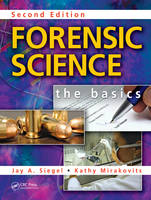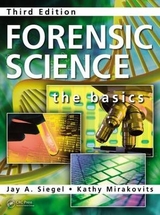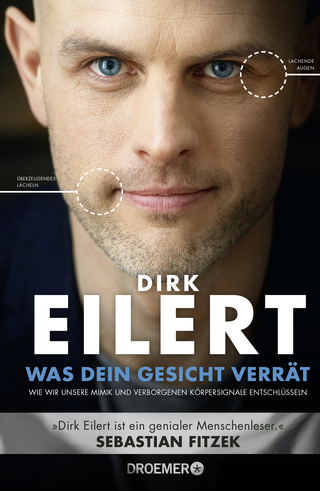
Forensic Science
Crc Press Inc (Verlag)
978-1-4200-8902-8 (ISBN)
- Titel erscheint in neuer Auflage
- Artikel merken
As forensic science continues to play a wider role in the investigation of crimes and apprehension of criminals, those without crime scene or crime lab training must now become familiar with the techniques and language of the forensic scientist. Avoiding the complicated science and graphic violence typical of most forensic references, this book is written specifically for those without forensic science experience. While it provides a professional reference for those not steeped in the details of forensic science, the wealth of instructor material available for teachers and its pedagogical approach make this an ideal textbook for high school and introductory level courses.
Following up on the tremendously popular first edition, Forensic Science: The Basics, Second Edition now adds the insight of a new co-author who is known nationally for training instructors how to teach forensic science at all levels of education. The book takes readers from the initial evidence collection process, through the evaluation procedures, right up to and including the courtroom presentation.
Packed with case studies, photographs, and exercises, this book provides everything the non-scientist needs to be able to understand and utilize the vital research approaches that forensic science can offer.
"Test Yourself" questions at the end of each chapter familiarize you with the language and approaches needed to understand and communicate with experienced crime scene investigators and laboratory personnel.
Offering the forensic sciences at their most accessible, Forensic Science: The Basics, Second Edition is a valuable resource for detectives, journalists, prosecutors, defense attorneys, and other non-science professionals who need to understand, interpret, and report on the newest advances in crime scene investigation.
PowerPoint® lecture slides, test bank, and other ancillary material on CD-ROM is available with qualifying course adoption
Jay Siegel is currently Director of the Forensic and Investigative Sciences Program at Indiana University Purdue University, Indianapolis and Chair of the Department of Chemistry and Chemical Biology. He holds a Ph.D. in Analytical Chemistry from George Washington University. He worked for 3 years at the Virginia Bureau of Forensic Sciences, analyzing drugs, fire residues and trace evidence. From 1980 to 2004 he was professor of forensic chemistry and Director of the forensic science program at Michigan State University in the School of Criminal Justice. Dr. Siegel has testified over 200 times as an expert witness in 12 states, Federal Court and Military Court. He is Editor in Chief of the Encyclopedia of Forensic Sciences, author of Forensic Science: A Beginner’s Guide and Fundamentals of Forensic Science and has over 30 publications in forensic science journals. In February 2009, he was named Distinguished Fellow by the American Academy of Forensic Sciences. In April 2009 he named the Distinguished Alumni Scholar Award by his alma mater, George Washington University. Kathy Mirakovits teaches forensic science and physics at Portage Northern High School in Portage, Michigan. She holds a Masters Degree in Science Education from Western Michigan University and a Bachelors Degree in Science Education from Miami University, and has over 10 graduate hours in Forensic Science. Kathy has also served as science department chairperson for six years at Portage Northern. She has taught at the high school level in Ohio, California and Michigan for almost 20 years, and during that time has taught general science, physical science, chemistry, biology, earth science and physics. Additionally, Kathy conducts workshops across the United States for teachers who wish to learn the application of forensic science in a school curriculum. She has developed numerous forensic science educational products for a national science supplier and has lead workshops at the National Science Teachers Association (NSTA) in forensic science. Kathy lead the teacher steering committee for the Forensic Science Educational Conference sponsored by the American Academy of Forensic Science at Michigan State University in August 2008. Kathy has served as President of the Michigan Chapter of the American Association of Physics Teachers (AAPT) and has served as a curriculum writer for the Michigan Department of Education. Currently, Kathy serves as Director at Large for the Michigan Science Teachers Association. She has received the RadioShack Science Teaching Award and was a State Finalist for the Presidential Award for Excellence in Math and Science Teaching (PAEMST).
Part I: Forensic Science and Investigation
Introduction to Forensic Science
Learning Objectives
Miniglossary
Acronyms
Introduction
What Is Forensic Science?
History and Development of Forensic Science
What Is a Forensic Scientist?
Career Information
The United States Forensic Science System
Other Forensic Science Systems
The Organization of Forensic Science Laboratories
Summary
Test Yourself
Further Reading
On the Web
Crime Scene Investigation
Learning Objectives
Miniglossary
Introduction
The Crime Scene as Recent History
Crime Scene Investigation Process
Summary
Test Yourself
Further Reading
On the Web
The Nature of Evidence
Learning Objectives
Miniglossary
Introduction
Classification of Evidence
Identification
The DNA Typing Situation
Positive and Negative Controls
Summary
Test Yourself
Further Reading
Part II: Tools of the Trade
Separating Complex Mixtures
Learning Objectives
Miniglossary
Acronyms
Introduction
Physical Separation of Solid Mixtures
Solid Phase Extractions
Chromatography
Summary
Test Yourself
Further Reading
On the Web
Light and Matter
Learning Objectives
Miniglossary
Introduction
What Is Light?
Light as a Wave: The Electromagnetic Spectrum
Properties of Waves
The Energy of Light: The Photon
Interactions of Light Energy and Matter
Mass Spectrometry
Summary
Test Yourself
Further Reading
On the Web
Microscopy
Learning Objectives
Miniglossary
Acronyms
Introduction
Types of Microscopes
Forensic Microscopy
The Lens: How Objects Are Magnified
The Compound Microscope
Modifications of the Compound Microscope
Electron Microscopy
Summary
Test Yourself
Laboratory Activities for Chapter Six
Further Reading
On the Web
Part III: Patterns and Impressions
Fingerprints and Other Impressions
Learning Objectives
Mini Glossary
National Institute for Standards and Technology (NIST) and
the National Crime Information Center (NCIC)
Introduction
The Quest for a Reliable Method of Personal Identification
The Origin of Fingerprints
The Anatomy of Fingerprints
Detection and Visualization of Fingerprints
Comparison of Fingerprints
Comparison of Single Fingerprints
Automated Fingerprint Identification Systems (AFIS and IAFIS)
Common Questions about Fingerprints
Other Impressions: Footwear and Tire Treads
Summary
Test Yourself
Mini Laboratory Activities
Further Reading
On the Web
Questioned Documents
Learning Objectives
Miniglossary
Acronyms
Introduction
What Is a Questioned Document?
The Questioned Document Examiner
Handwriting Analysis
Fraud and Forgery
Erasures, Obliterations, and Alterations
Typewriters, Photocopiers, and Computer Printers
Paper Examination
Ink Examinations
Physical Matches on Torn Paper
Summary
Test Yourself
Further Reading
On the Web
Firearms and Toolmarks
Learning Objectives
Miniglossary
Introduction
Firearms Identification
The Anatomy of a Live Round (Cartridge)
Examination of Firearms Evidence
Digital Imaging Systems for Ammunition
Distance of Fire Determinations
Toolmarks
Summary
Test Yourself
Further Readings
On the Web
Part IV: Forensic Biology
Forensic Pathology
Learning Objectives
Miniglossary
Acronyms
Introduction
How to Become a Forensic Pathologist
Investigation of Death: Coroners and Medical Examiners
Death Investigation Process
The Postmortem Interval (PMI)—Time of Death
Exhumations
The Teamwork Approach
Summary
Test Yourself
Further Reading
On the Web
Anthropology and Odontology
Learning Objectives
Miniglossary
Introduction
The Human Skeleton
Identification of Skeletal Remains
The Significance of Age
The Biological Profile
Individualization of Human Bone
Collection of Bones
Forensic Odontology
Summary
Test Yourself
Further Reading
On the Web
Forensic Entomology
Learning Objectives
Miniglossary
Introduction
Becoming a Forensic Entomologist
The PMI: The Life Cycle of the Blowfly
Decomposition of a Body after Death
Factors that Affect PMI
Entomological Investigation and Evidence Collection
Summary
Test Yourself
Further Reading
On the Web
Serology
Learning Objectives
Miniglossary
Introduction
Blood
Analysis of Blood
Other Biological Fluids and Stains
Bloodstain Pattern Analysis
Bloodstain Pattern Analysis
Summary
Appendix A
Test Yourself
On the Web
Further Reading
DNA Typing
Learning Objectives
Miniglossary
Acronyms
Introduction
What Is DNA?
Collection and Preservation of DNA Evidence
DNA Typing
The Polymerase Chain Reaction
Short Tandem Repeats (STRs)
Mitochondrial DNA
CODIS: The Combined DNA Index System
Summary
Test Yourself
Further Reading
On the Web
Hair
Learning Objectives
Miniglossary
Introduction
What Is Hair?
Hair Growth
Hair Color
The Structure of Human Hair
Human v. Non-Human Hairs
Hair Treatment and Damage
Comparison of Human Hairs
What Can Be Determined from the Structure of Hair?
DNA Analysis of Hair
Hair as a Source of Drugs
Summary
Test Yourself
Laboratory Activities for Chapter Fifteen
Further Reading
On the Web
Part V: Forensic Chemistry
Illicit Drugs
Learning Objectives
Miniglossary
Acronyms
Introduction
Illicit Drugs
The Control of Illicit Drugs in the United States
Classification of Illicit Drugs
Analysis of Illicit Drugs
Summary
Test Yourself
Further Reading
On the Web
Forensic Toxicology
Learning Objectives
Miniglossary
Acronyms
Introduction
Forensic Toxicology
Principles of Pharmacology
Pharmacology and Toxicology of Ethyl Alcohol
Drunk Driving Laws
Field Sobriety Testing
Measurement of BAC
Summary
Test Yourself
Laboratory Activities for Chapter Seventeen
Further Reading
On the Web
Fibers, Paints, and Other Polymers
Learning Objectives
Miniglossary
Introduction
What Is a Polymer?
Textile Fibers
Types of Fibers
Fiber Morphology
Analysis of Synthetic Fibers
Chemical Analysis of Fibers
Interpretation of Fiber Evidence
Paints and Other Coatings
Types of Paint
How Cars Are Painted
Collection of Paint Evidence
Analysis of Paint
The Evidentiary Value of Paint
Summary
Test Yourself
Further Readings
On the Web
Glass and Soil
Learning Objectives
Mini Glossary
Introduction
Glass
Glass as Forensic Evidence
Analyzing Broken Glass
Soil
Summary
Test Yourself
Further Reading
On the Web
Fires and Explosions
Learning Objectives
Miniglossary
Acronyms
Introduction
What Is a Fire?
Extinguishing a Fire
Incendiary Fires
Investigation of a Fire
The Role of Accelerants
Analysis of Fire Scene Evidence
Analysis of Accelerants
Explosions
Investigation of Bombing Scenes
Summary
Test Yourself
Laboratory Activities for Chapter Twenty
Further Reading
On the Web
Part VI: Legal Aspects of Forensic Science
Forensic Science and the Law
Learning Objectives
Miniglossary
Admissibility of Evidence
Laboratory Reports
Expert Testimony
Summary
Test Yourself
Laboratory Activities for Chapter Twenty-one
Further Reading
On the Web
INDEX
| Erscheint lt. Verlag | 12.3.2010 |
|---|---|
| Zusatzinfo | Replace 2 figure pgs 3rd print!! Pgs 174 & 175; 29; 14 Tables, black and white; 266 Illustrations, black and white |
| Verlagsort | Bosa Roca |
| Sprache | englisch |
| Maße | 216 x 279 mm |
| Gewicht | 1814 g |
| Themenwelt | Recht / Steuern ► Strafrecht ► Kriminologie |
| ISBN-10 | 1-4200-8902-1 / 1420089021 |
| ISBN-13 | 978-1-4200-8902-8 / 9781420089028 |
| Zustand | Neuware |
| Haben Sie eine Frage zum Produkt? |
aus dem Bereich



